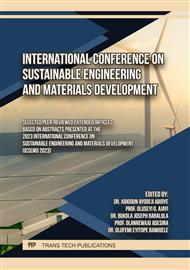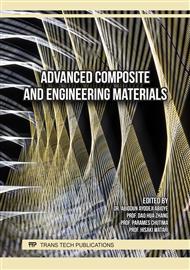[1]
Rokbi, M., Osmani, H., Imad, A., and Benseddi,q N. Effect of chemical treatment on flexure properties of natural fiber-reinforced polyester composite. procedia Engineering 10 (2011): 2092-2097.
DOI: 10.1016/j.proeng.2011.04.346
Google Scholar
[2]
Bachtiar D, Sapuan S. M. and Hamdan M. M. The effect of alkaline treatment on tensile properties of sugar palm fibre reinforced epoxy composites," Mat. Desig .29 (2008)1285-1290.
DOI: 10.1016/j.matdes.2007.09.006
Google Scholar
[3]
Yousif B. F., Shalwan A, Chin C. W and K. C. Ming. Flexural properties of treated and untreated kenaf/epoxy composites. Materials & Design. 40 (2012) 378-385.
DOI: 10.1016/j.matdes.2012.04.017
Google Scholar
[4]
John M. J, and Thomas S. Biofibres and biocomposites. Carbohydrate Polymer. 71 (2008) 343–364.
DOI: 10.1016/j.carbpol.2007.05.040
Google Scholar
[5]
Ramamoorthy, S. K., Skrifvars, M., and Persson, A. A review of natural fibers used in biocomposites: Plant, animal and regenerated cellulose fibers. Polymer reviews, 55(1) (2015) 107-162.
DOI: 10.1080/15583724.2014.971124
Google Scholar
[6]
Imoisili, P. E., and Jen, T. C.. Mechanical and Acoustic Performance of Plantain (Musa Paradisiacal) Fibre Reinforced Epoxy Bio-Composite. Journal of Natural Fibers. (2022) 1-8.
DOI: 10.1080/15440478.2022.2036289
Google Scholar
[7]
Kaith B. S. and Kalia S. Synthesis and characterization of graft co-polymers of flax fibre with binary vinyl monomers, Journal of. Polymer. Analysis. Characterization. 12 (2007) 401-412.
DOI: 10.1080/10236660701543676
Google Scholar
[8]
Cao Y, Shibata S. and Fukumoto I. Mechanical properties of biodegradable composites reinforced with bagasse fibre before and after alkaline treatments. Composite Part A 37 (2006) 423-429.
DOI: 10.1016/j.compositesa.2005.05.045
Google Scholar
[9]
Calado, V, Barreto, D. W, and D'almeida, J. R. M. The effect of a chemical treatment on the structure and morphology of coir fibers. Journal of material Science letters 19 (2000). 2151-2153.
Google Scholar
[10]
Kaushik, V. K., Kumar, A., and Kalia, S. Effect of mercerization and benzoyl peroxide treatment on morphology, thermal stability and crystallinity of sisal fibers, International Journal of Textile Science. 1(6) (2012) 101-105.
DOI: 10.5923/j.textile.20120106.07
Google Scholar
[11]
Li, Y., Hu, C. J., and Yu, Y. H. Interfacial studies of sisal fiber reinforced high density polyethylene composite. Compos. Part A, 39 (2008) 570-578.
DOI: 10.1016/j.compositesa.2007.07.005
Google Scholar
[12]
Mishra, S., Misra, M., Tripathy, S. S., Nayak S. K., and Mohanty, A. K. Potentiality of pineapple leaf fibre as reinforcement in PALF-Polyester composite: surface modification and mechanical performance. J Reinf. Plast. Compos. 20(4), (2001) 321-334.
DOI: 10.1106/qwr6-32vv-k720-596d
Google Scholar
[13]
Christian Emeka Okafor, Anthony Chinweuba Onovo, Patrick Ehi Imoisili, Kedar Madhusudan Kulkarni, Christopher Chukwutoo Ihueze. Optimal route to robust hybridization of banana-coir fibre particulate in polymer matrix for automotive applications. Materialia. (2021) 101098
DOI: 10.1016/j.mtla.2021.101098
Google Scholar
[14]
Chimekwene, C. P., Fagbemi, E. A., and Ayeke, P. O. Mechanical properties of plantain empty fruit bunch fiber reinforced epoxy composite. International Journal of Research in Engineering, IT and Social Sciences, 2(6) (2012) 86-94.
Google Scholar
[15]
Cadena Ch, E. M., Vélez R, J. M., Santa, J. F., and Otálvaro G, V. Natural fibers from plantain pseudostem (Musa paradisiaca) for use in fiber-reinforced composites. Journal of Natural Fibers, 14(5) (2017) 678-690.
DOI: 10.1080/15440478.2016.1266295
Google Scholar
[16]
Imoisili, P. E., and Jen, T. C. Mechanical Properties of Polyester Resin Reinforced with Treated Plantain Pseudo Steam Fibers. Key Engineering Materials. 917 (2022) 32-37
DOI: 10.4028/p-bzxe78
Google Scholar
[17]
Imoisili, P. E., and Jen, T. C. Mechanical and water absorption behavior of potassium permanganate (KMnO4) treated plantain (Musa Paradisiaca) fibre/epoxy bio-composites. J Mater Res Technol. 9(4) (2020). 8705–8713
DOI: 10.1016/j.jmrt.2020.05.121
Google Scholar
[18]
Imoisili, P. E., Ukoba K. O., Jen T-C. Physical, Mechanical and Thermal Properties of High Frequency Microwave Treated Plantain (Musa Paradisiacal) Fibre/MWCNT Hybrid Epoxy Nanocomposites. J Mater Res Technol. 9(3) (2020) 4933-4939.
DOI: 10.1016/j.jmrt.2020.03.012
Google Scholar
[19]
Patra, A., and Bisoyi D. K. Investigation of the electrical and mechanical properties of short sisal fibre-reinforced epoxy composite in correlation with structural parameters of the reinforced fibre," J Mater. Sci. 46 (2011) 7206–7213.
DOI: 10.1007/s10853-011-5676-4
Google Scholar
[20]
Klemm D, Heublein B, Fink H. p. and Bohn A. Cellolose: Fascinating biopolymer and sustainable raw material. Angew Chem, Int. Ed. 44 (2005)3358–3393.
DOI: 10.1002/anie.200460587
Google Scholar
[21]
Patra, A., Bisoyi Dillip K., Manda Prem K., Singh A. K. Effect of microwave radiation on the macromolecular, morphological and crystallographic structures of sisal fibre, Appl. Phys. A., 112 (2013) 1063–1071
DOI: 10.1007/s00339-012-7489-y
Google Scholar
[22]
Esmeraldo M. A, Barreto A. C. H, Freitas J. E. B, Fechine P. B. A. Sombra A. S. B., Corradini E., Mele G., Maffezzoli A. and Mazzetto S. E. Dwarf-green coconut fibres: versatile natural renewable raw bioresource. Treatment morphology and physicochemical properties. BioResources. 5, (2010). 478–501.
DOI: 10.15376/biores.5.4.2478-2501
Google Scholar
[23]
Barreto A. C. H., Rosa, D. S, Fechine P. B. A., and Mazzetto, S. E. Properties of sisal fibers treated by Alkaline solution and their application into cardanol-based biocomposites, Compos. Part A. 42 (2011)492–500.
DOI: 10.1016/j.compositesa.2011.01.008
Google Scholar
[24]
Ouajai S. and Shanks R. A. (2005). "Composition, structure and thermal degradation of hemp cellulose after chemical treatments," Polym Degrad. Stabil. 89, 327–335.
DOI: 10.1016/j.polymdegradstab.2005.01.016
Google Scholar
[25]
Imoisili P. E., Jen T-C. Modelling and Optimization of the Impact Strength of Plantain (Musa Paradisiacal) Fibre/MWCNT Hybrid Nanocomposite Using Response Surface Methodology. J Mater Res Technol. 13 (2021) 1946-1954
DOI: 10.1016/j.jmrt.2021.05.101
Google Scholar



